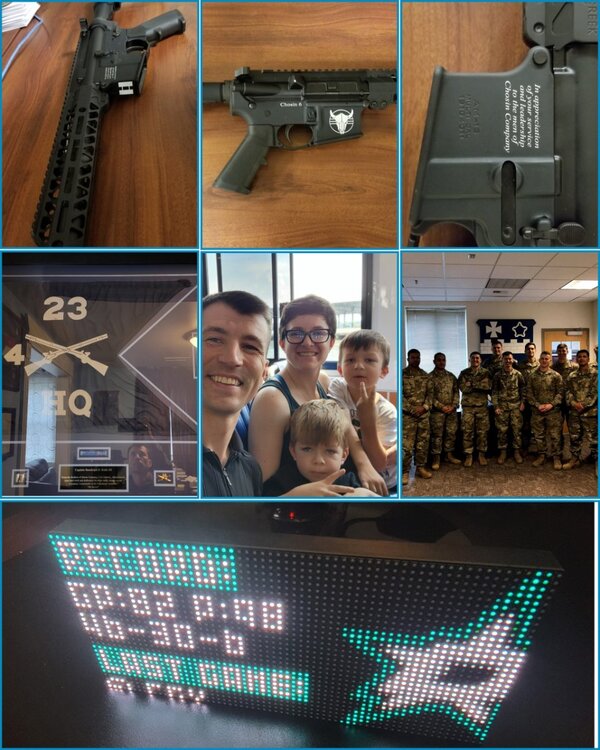-
Posts
286 -
Joined
-
Last visited
-
Days Won
27
Content Type
Profiles
Forums
Events
Articles
Posts posted by Rotte 8th ID
-
-
I look forward to the newsletter every month and this one definitely did not disappoint! Thanks for making this every month and entertaining us all!
-
Don't think the argument holds up right now 😬
-
-
So you all went sentimental on me! I was going to be simple and just put in my NHL scoreboard that I built and programmed last year that sits on my desk and gives me live updates on the Stars and all around the NHL (bottom picture).
In the center is my wife and kids from a few weeks ago. My sons Andy (7 with the peace sign) and James (4 in middle) are wonderful little guys and I'm very lucky they've turned out so well. Of course, my wife in the center is someone I don't deserve and who I work everyday to try and be a good husband to.
My other two great accomplishments were commanding, at least somewhat well, two different companies of Soldiers in the Army. The middle right is all the Sergeants and Staff Sergeants who were my squad leaders and who I leaned on heavily to make things happen. I worked daily to earn their respect. The middle left is my going away gift from my second command where I led a headquarters company full of staff officers and Soldiers. The top three are my going away gift from my first company that caught me completely by surprise and is one of my most treasured possessions.
-
 8
8
-
-
I've got a bunch of multiplayer games in my steam library that I'd love to explore with other people in our unit/community. Please post whatever games you either already enjoy or would like to try with people!
Already Play:
-Overwatch
-CSS/CSGO (prefer CSS)
-League of Legends
-Overcooked 2
-Squad
-Insurgency: Sandstorm
-Tabletop Simulator
-War Thunder
-WarframeWant to Play:
-Borderlands 3
-Hell Let Loose
-Day of Infamy
-Destiny 2
-Rocket League
-Rainbow Six Seige -
The picks lock after tomorrow, get yours done within the next 24 hours!
-
December:
15 December
Last month, we covered Battle of Aachen and discussed how the Allies gained their first foothold in German territory through a hard fought victory at the town of Aachen.
Battle Covered
The first battle for tonight is the Bombing of Dresden. In the last months of World War II, Allied bombers from the British Royal Air Force and the United States Army Air Force conducted several major bombing raids on the eastern German city of Dresden. One tactic used by the Royal Air Force and the United States Army Air Force at the time was the creation of firestorms. This was achieved by dropping incendiary bombs, filled with highly combustible chemicals such as magnesium, phosphorus or petroleum jelly (napalm), in clusters over a specific target. After the area caught fire, the air above the bombed area, become extremely hot and rose rapidly. Cold air then rushed in at ground level from the outside and people were sucked into the fire. In 1945, it was decided to use this tactic in the medieval city of Dresden. According to the RAF at the time, Dresden was Germany's seventh-largest city and the largest remaining unbombed built-up area. The Allies considered it a good target as it had not been attacked during the war and was virtually undefended by anti-aircraft guns. The population of the city was now far greater than the normal 650,000 due to the large numbers of refugees fleeing from the advancing Red Army. Beginning on the night of February 13, 1945, more than 1,200 heavy bombers dropped nearly 4,000 tons of high-explosive and incendiary bombs on the city in four successive raids. During the next two days the USAAF sent over 527 heavy bombers to follow up the RAF attack. Dresden was nearly totally destroyed. An estimated 25,000 people were killed in the bombings and the firestorm that raged afterward. More than 75,000 dwellings were destroyed, along with unique monuments of Baroque architecture in the historic city center. This raid has been widely criticized and questioned since its occurrence as to the actual relevance to the German war effort, some going as far as to call it a war crime.
In March of 1945 a German raiding force from the Channel Islands launched a daring attack on a port in Allied-occupied France. Granville, Manche, France was the site of a prisoner of war camp. In December 1944 four German paratroopers and a Naval cadet escaped from the camp, eventually stole an American LCVP landing craft, and made their way to the German occupied Channel Islands. They reported that several ships were in the harbor at Granville discharging coal, which was in short supply in the beleaguered Islands. They also reported on the disposition of American troops in the area. The new garrison commander of the Channel Islands used the intelligence to plan a raid against the Allies to restore morale to his garrison and obtain needed supplies. On the night of February 6th 1945, a first attempt was aborted, due to a combination of bad weather and the detection of an escorting Schnellboot ("E-boat"), by a US Navy submarine. The raid was carried out on the night of 8 March. The raiding force comprised four large M class minesweepers, three armed barges carrying 8.8 cm guns, three fast motor launches, two small R type minesweepers, and a sea-going tug. As the Germans had received intelligence regarding the identification signals needed to enter the harbor, they were initially able to land unopposed. They damaged the harbor locks and started fires on shore. The Germans mined the British-registered merchant freighters Kyle Castle, Nephrite, Parkwood and the Norwegian freighter Heien. Outside the port, a submarine chaser, raised the alarm and was attacked by German vessels. About 14 US Navy personnel were killed in action, others were wounded, its 3-inch gun was disabled and the pilot house destroyed. The captain gave the order to abandon ship, but he and other crew members remained on board, and managed to evade the Germans, before intentionally grounding on the shore. Some claim that 30 Allied personnel were taken, as prisoners to the Channel Islands, including 15 of those who had earlier abandoned ship. Allied resistance caused significant delays to the German raiders. By the time they were ready to depart, the tide was so low that only one captured collier containing 112 tons of coal, could be taken back to the Channel Islands. A German minesweeper ran aground and was scuttled with explosives.With that, we will now talk about how the war closed out. I’ll bring the Pacific and Russian actions into the fold and complete the war from there. June 22, 1944, the Soviets launch a massive offensive in eastern Belorussia (Belarus), destroying the German Army Group Center and driving westward to the Vistula River toward Warsaw in central Poland by August 1. August 23, the appearance of Soviet troops on the Prut River induces the Romanian opposition to overthrow the Antonescu regime. The new government concludes an armistice and immediately switches sides in the war. The Romanian turnaround compels Bulgaria to surrender on September 8, and the Germans to evacuate Greece, Albania, and southern Yugoslavia in October. September 4, Finland agrees to sign an armistice with the Soviet Union and to expel German forces. October 20, US troops land in the Philippines. December 16, the Germans launch a final offensive in the west, known as the Battle of the Bulge, in an attempt to re-conquer Belgium and split the Allied forces along the German border. By January 1, 1945, the Germans are in retreat. January 12, the Soviets launch a new offensive, liberating Warsaw and Krakow in January. They capture Budapest after a two-month siege on February 13, driving the Germans and their Hungarian collaborators out of Hungary in early April. March 7, US troops cross the Rhine River at Remagen. April 13, Soviet forces capture Vienna. April 16, the Soviets launch their final offensive, encircling Berlin. April 30, Hitler commits suicide. May 7, Germany signs an unconditional surrender at the headquarters of US General Dwight D. Eisenhower, Commander of Allied forces in northwest Europe, at Reims on May 7. The surrender takes effect on May 8 at 11:01 PM Central European time. May 8, Germany signs a second, very similar, document of surrender in Berlin. It also comes into effect on May 8 at 11:01 PM CET. In Moscow, this was already after midnight on May 9. May, Allied troops conquer Okinawa, the last island stop before the main Japanese islands. August 6, the United States drops an atomic bomb on Hiroshima. August 8, the Soviet Union declares war on Japan and invades Manchuria. August 9, the United States drops an atomic bomb on Nagasaki. September 2, having agreed in principle to unconditional surrender on August 14, 1945, Japan formally surrenders, ending World War II.
Overall, by the end of World War II the cost to life and material was staggering. At the start of the war, there were an estimated 2.3 billion people on earth. Between 21 to 25.5 million military deaths, 29 to 30.5 million civilian war casualties and another 19 to 28 million civilians deaths due to famine and disease occurred during those 6 years. The total dead, not including injured, is between 70 to 85 million people, about 3.5% of the world’s population at the time. The holocaust alone was the cause of around 5 million deaths. The most effect countries were Poland, who lost about 20% of their pre-war population, and Russia, Yugoslavia and Germany who lost about 10% of their pre-war population. The material costs to all involved totaled more than 1 trillion dollars.Unit Covered:
n/a -
This campaign has come to a close tonight. Thank you for coming out and participating in this event all year! It's been awesome sharing history of battles and units from WW II with all of you! I look forward to the next event like this that we run in the future.
-
 4
4
-
 1
1
-
-
If anyone wants to join, I've created a group on ESPN for anyone who wants to play bowl mania for the college football bowls this year. Link to the group is below. Come try and beat me!
https://fantasy.espn.com/games/college-football-bowl-mania-2021/group?id=256f879f-a6c1-4a45-933c-f177c781cd46&joining=true&joinKey=971c080c-caad-3462-9768-82340913702e8th ID Bowl Picks
Password: only8ths
-Rotte
-
November:
17 November
Last month, we covered Operation Market Garden and how the Allies attempted to speed up the European campaign and failed to do with Market Garden’s failure. We also talked about the US Army’s 82nd Airborne Division
Battle Covered
By the autumn of 1944, German resistance in the West was quickly crumbling as the British and Americans approached the German border. Aachen was one of the largest and toughest urban battles fought by US forces in World War Two, and the first city on German soil to be captured by the Allies. This was a pivotal battleground for American soldiers breaching the fortified Siegfried Line in the fall of 1944. After the failure of Operation Market Garden, the Allied advance toward Berlin slowed as supplies dwindled due to the time it took to transport them through France. Aachen was set as the target for the US First Army. It was believed the ancient and picturesque city would only be held only by a small garrison, which would presumably surrender once isolated. Indeed the German commander in Aachen had planned to surrender the city as American troops encircled it, but when his letter fell into German hands, Hitler had him arrested. His unit was replaced by 3 full divisions of the Waffen-SS, the most elite German fighters. Although a city of little military value, it was nonetheless of huge strategic importance – both as the first German city threatened by a foreign army during World War Two, but also as an important symbol to the Nazi regime as it was the ancient seat of Charlemagne, founder of the ‘First Reich’, and thus also of immense psychological value to the Germans. Aachen was formidably protected by belts of pillboxes, barbed wire, anti-tank obstacles and other impediments. In some places these defenses were over 10 miles deep. The narrow streets and layout of the city were also of advantage to the Germans, as they denied access to tanks. As a result, the US plan of action was to surround the city and meet in the middle rather than battle their way through the city’s streets. On 2 October the attack began with a heavy bombardment and bombing of the city’s defenses. During the first days of the assault, the armies attacking from the north were engaged in a fearsome hand-grenade battle as they took pillbox after pillbox, in a flight reminiscent of parts of World War One. Once the Americans had taken the outlying town of Übach, their German opponents suddenly launched a major counterattack in a desperate bid to pin their advance back. Despite attempting to cobble together all the air and armored reserves at their disposal, American tank superiority ensured that the counterattack was decisively rebuffed. Meanwhile on the south side of the city a simultaneous advance met with equal success. Here the preceding artillery bombardment proved far more effective, and the advance was slightly more straightforward. By 11 October the city was surrounded, and the Allies demanded that the city surrender or face devastating bombardment. The garrison categorically refused. Soon afterwards, the city was bombed and bombarded savagely, with 169 tons of explosives dropped on the beautiful old center on that day alone. The next 5 days were the toughest yet for the advancing American troops, as the Wehrmacht troops countered repeatedly whilst defending the fortified perimeter of Aachen bravely. As a result, the American armies failed to link up in the center of the city, and their casualties mounted. With most of the American soldiers needed on the perimeter, the task of taking the center of the city fell to the 26th Infantry Regiment. These troops were aided by a handful of tanks and one howitzer, but were far more experienced than the city’s defenders. The Wehrmacht took advantage of the maze of old streets to stall the 26th’s advance. Some used the narrow alleys to ambush the advancing tanks, and often the only way forward for the Americans was to literally blast their way through the city’s buildings at point blank range in order to reach the center. By 18 October the remaining German resistance was centered around the opulent Quellenhof hotel. Despite bombarding the hotel at point blank range, the Americans failed to take it, and were actually pushed back some distance by a concerted counter by 300 SS operatives. However, eventually US air and artillery superiority won-through, and after reinforcements began to pour into the city, the last German garrison in the Quellenhof bowed to the inevitable and surrendered on 21 October. The fall of the city was a turning point for the Allies in the war, and a further blow to the flagging Wehrmacht, which lost 2 divisions and had 8 more badly maimed. The city’s capture provided the Allies with an important morale boost – after many months of slogging through France they were now advancing into the German industrial heartland of the Ruhr Basin, the heart of Hitler’s Reich.
Unit Covered:
n/a
-
October:
20 October
Last month, we covered Operation Cobra and how the Allies made their first real movement into Europe after D Day to get the campaign towards Berlin started. We also talked about the US Army’s 8th Infantry Division.Battle Covered:
In the summer of 1944 General Montgomery came up with an ambitious scheme to cross the River Rhine and advance deep into northern Germany and shorten the war. Codenamed 'Market Garden', his plan involved the seizure of key bridges in the Netherlands by the 101st and 82nd US Airborne Divisions, and 1st British Airborne Division who would land by parachute and glider. The Allied Forces had halted their advance after liberating Brussels in early September 1944. Operation Market Garden started on 17 September 1944. The two-pronged plan consisted of Operation Market, the airborne assault, and Operation Garden, the ground attack. The ground forces of the British XXX Corps had just three days to advance all the way from the Belgian border up to the city of Arnhem. In order for this to succeed, the bridges along the road would have to be captured by the American 101st and 82nd Airborne Divisions, and the British 1st Airborne Division. Montgomery hoped that the success of the operation would mean an end to the war by Christmas 1944. Despite being one of the biggest airborne operations in history, Operation Market Garden was only partly successful. On 17 September 1944, thousands of paratroopers and military equipment dropped from the sky. The Allied Forces advanced slowly. The ground forces had to drive north over a narrow two-lane road. Under constant fire by German soldiers, they called the route ‘Hell’s Highway'. On 20 September 1944, despite heavy German resistance, the Allies managed to capture the bridges across the Waal in Nijmegen. Operation Market Garden was terminated on 25 September 1944. Even the assistance of the Polish First Independent Parachute Brigade proved futile. Sadly, the Allied Forces did not manage to capture the last bridge near Arnhem. Arnhem quite literally proved to be ‘a bridge to far’. On 24-25 September about 2,100 troops from 1st Airborne Division were ferried back across the Rhine. Another 7,500 were either dead or made prisoners of war. The crossing of the Rhine and the capture of Germany's industrial heartland were delayed for six months. Now, the Allies would have to fight their way into the Reich on a broad front.Units Covered:
The U.S. Army’s 82nd Airborne Division came into being on August 5th, 1917 at Camp Gordon, Georgia. It was composed entirely of drafted Soldiers. Most of the Soldiers came from Alabama, Georgia, and Tennessee but draftees from across the U.S. were brought in to fill shortages. This led the Division being name “All American,” as it was the only Division to have Soldiers from all 48 states. The Division departed from New York and Massachusetts to land in Liverpool, England and deploy to France. It participated in the Battle of Saint-Mihiel and the Meuse-Argonne Offensive during World War I. During the latter, Sergeant Alvin C. York earned his Medal of Honor while rushing a German machine gun nest and capturing over 100 German Soldiers and killing 23, all single-handedly. The Division returned to the U.S. after the war and deactivated in May of 1919. On 13 February 1942, the Division was reactivated following the attack on Pearl Harbor. It returned to full service at Camp Clairborne, Louisiana under command of Major General Omar Bradley in March. In August 1942, the Division became the first airborne division and was renamed the 82nd Airborne Division. The Division was reorganized to contain one glider infantry regiment and two airborne infantry regiments prior to shipping to the Mediterranean. Its first two operations were airborne assaults into Sicily and Salerno. Throughout World War II, the 82nd conducted airborne and glider operations including into Normandy and during Operation Market Garden, fought in the Battle of the Bulge and were part of the invasion into Germany. During World War II, Paratroopers from the Division earned over 1,800 Bronze Stars, 898 Silver Stars, 37 Distinguished Service Crosses, and 4 Medals of Honor. On January 3rd, 1946, the Division returned to the United States. The Division was not deactivated but moved its home base to Fort Bragg, North Carolina. In 1957, it was reorganized to better prepare for a potential nuclear war and created 5 battle groups instead of 3 regiments. In April 1965, the Division enter the civil war in the Dominican Republic as part of Operation Power Pack. The 82nd’s 3rd Brigade was deployed to Vietnam in 1968 to support the Tet Offensive. The 82nd also served as a policing force during the urban riots across the U.S. from 1967-1968. During the 1970’s, the Division conducted multiple exercises as preparation for future wars. In 1983, the Division jumped into Grenada as part of Operation Urgent Fury to retrieve American citizens from the country following a military Coup. In 1989, the Division again conducted an airborne operation in Panama as part of Operation Just Cause to maintain the panama canal, safeguard American citizens, defend human rights and combat drug trafficking. The 82nd was part of the spearhead into Iraq during Operation Desert Shield/Desert Storm in 1991. From 1992 to 2001, the Division was part of the Hurricane Andrew relief, Operation Restore Democracy: Haiti, the Panama Canal, Bosnia, Centrazbat, and Kosovo. After the War on Terror began, elements of the Division participated in OIF, OEF, the Surge in Iraq, the transition in Afghanistan, the Haiti earthquake, Hurricane Katrina, the Syrian intervention, the U.S. embassy in Baghdad, and most recently the evacuation at Kabul Airport. Notable to our unit, T/3 Hershman and myself have both served in the 82nd Airborne Division.
-
 2
2
-
-
My carry is the same every time I leave the house:
Left front pocket is my cell phone and a "placker" for my teeth.
Front right pocket is my car key, a black Precise V5 Pilot pen, and my wallet.
My left wrist is my running watch and a remembrance bracelet for SGT Meddock.
My right wrist is a remembrance bracelet for 2LT Rylander.
Wear my wedding ring and my USMA class ring every day.
Only addition, depending on if I can conceal carry in the state or not (which I currently can't in NY), is a back right, inner belt, leather holster with my P226 Elite .40.-
 1
1
-
-
September:
29 September
Last month, we covered the Battles of Caen and Carentan and how the Allies’ continued their push into Europe after the initial landings on D-Day. We also talked about the Canadian 2nd Corps.Battle Covered:
Operation Cobra was conducted from July 25 to 31, 1944. Six weeks after the Allied invasion of Normandy, Operation OVERLORD showed distressing signs of stalemate. More than a million American, British, and Canadian troops had come ashore in France by mid-July 1944, but they remained wedged within a narrow bridgehead roughly fifty miles wide and twenty miles deep. Both German defenders and Allied attackers had suffered more than 100,000 casualties. Initial efforts were hampered by the need to take the city of Caen in the east and the dense hedgerow country in the west. Seeking to launch a major breakout, General Omar Bradley sought to focus the Allies' efforts on a narrow front west of St. Lô. Bradley’s plan for the operation code-named ‘Cobra’ was for a specific location on the German front to be carpet-bombed, then stormed by infantry, and finally penetrated by an armored spearhead. The key concept here was extreme concentration – of firepower, assault troops, and armor – to open a narrow gap through which the tanks could pass into the open country beyond. Though the British operations commenced on July 18, Bradley elected to delay several days due to poor weather over the battlefield. On July 24, Allied aircraft began striking the target area despite questionable weather. As a result, they accidentally inflicted around 150 friendly fire casualties. Operation Cobra finally moved forward the next morning with over 3,000 aircraft striking the front. The bombing had unhinged German defenses almost precisely as planned. In addition to killing perhaps a thousand German soldiers and demolishing numerous command posts, the bombardment overturned tanks, demolished enemy communications, and terrified those who survived the onslaught only to face several attacking U.S. Army infantry divisions. Late on the afternoon of July 25, the VII Corps commander sent his armor exploitation force into the breach. The next day, the German Seventh Army reported seven ruptures in the line from east to west. By the night of July 27, the 30th Infantry Division, which had suffered most of the fratricidal casualties earlier in the week, reported that the battle had busted wide open. Things got even better. More than 100,000 combat troops poured south through a gap not five miles wide, soon turning the German left flank and capturing several key bridges near Avranches, the gateway from Normandy to Brittany. The march into Europe had truly begun for the Allies. Overall, the battle included 11 U.S. Divisions and 8 German Divisions, with over 1,800 U.S. casualties and over 100 tanks destroyed while the Germans suffered over 2,500 killed and over 10,000 captured with over 3,000 vehicles and artillery pieces destroyed.Units Covered:
The U.S. Army’s 8th Infantry Division, nicknamed either the Golden Arrow Division or Pathfinders, was activated on January 5, 1918 at Camp Fremont, California and initially comprised of two Infantry brigades, one field artillery brigade, one machine gun battalion, one engineer regiment, one signal battalion, one support battalion and a military police company. The Division was activated to fight in World War I and was moved to Siberia in October of 1918. Only part of the Division made it to France, as the armistice was signed during transport and those on boats were turned around. The rest of the Division followed shortly after in January of 1919 and disbanded in September 1919. Part of the Division was reactivated in March of 1923 and placed under the U.S. Army’s III Corps at Camp Meade, Maryland. These units were on standby in case of war and conducted annual training. On July 1st 1940, the Division was fully reactivated and manned to fight in World War II. After receiving all of their Soldiers, the Division conducted training at Fort Leonardwood, Missouri in 1942 and Camp Laguna, California in 1943. In December of 1943 the Division deployed overseas to begin combat operations. The Division trained in Ireland until it took part in the D-Day landings at Normandy. During World War II the Division participated in the Normandy landings, Operation Overlord, the Siegfriend Line Campaign, and the Western Allied Invasion of Germany. The Division was one of the units to discover SS run concentration camps and liberate the prisoners. During World War II, Pathfinders earned over 2,800 Bronze Stars, 2 Distinguished Flying Crosses, 768 Silver Stars, 33 Distinguished Service Crosses, and 3 Medals of Honor. The Division returned to the U.S. in 1945 and was deactivated that same year. It was reactivated again in 1950 as a training Division at Fort Jackson, South Carolina. In 1954, it became and active Division again and was moved to Germany as part of Operation Gyroscope. It would remain there until its deactivation in 1992. Before deactivation, elements of the Division were deployed to support other Divisions during Operation Desert Shield/Desert Storm. In May 1991, all units had returned to Germany and the Division began to case its colors for the final time.
-
 1
1
-
-
August:
11 August
Last month, we covered the Battle of Brecourt Manor and how the Allies’ secured their foothold in France to begin their push towards Germany. We also talked about the U.S. Army’s 101st Airborne Division.Battle Covered:
The battle of Caen was one of the key battles during Operation Overlord, and although the British and Canadians achieved their main aims, the failure to capture Caen quickly caused a great deal of controversy. The British 3rd Infantry Division was to seize Caen on D-Day or dig in short of the city if the Germans prevented its capture, temporarily masking Caen to maintain the Allied threat against it and thwarting a potential German counter-attack from the city. Caen, Bayeux and Carentan were not captured by the Allies on D-Day and for the first week of the invasion the Allies concentrated on linking the beachheads. British and Canadian forces resumed their attacks in the vicinity of Caen and the suburbs and city centre north of the Orne were captured during Operation Charnwood from 8–9 July. The Caen suburbs south of the river were captured by the II Canadian Corps during Operation Atlantic from 18–20 July. The Germans had committed most of their panzer divisions in a determined defence of Caen, which made the fighting mutually costly and greatly deprived the Germans of the means to reinforce the west end of the invasion front.
In western Normandy the US First Army cut off the Cotentin Peninsula, captured Cherbourg and then attacked southwards towards Saint-Lô, about 37 mi west of Caen, capturing the town on 19 July. On 25 July, after a weather delay, the First Army began Operation Cobra on the Saint-Lô–Périers road, coordinated with the Canadian Operation Spring at Verrières ridge to the south of Caen. Cobra was a great success and began the collapse of the German position in Normandy; the Allied break-out led to the Battle of the Falaise Pocket, from 12–21 August, which trapped most of the remnants of the 7th Army and 5th Panzer Army, opening the way to the Seine and Paris. Caen was destroyed by Allied bombing which, with the damage from ground combat, caused many French civilian casualties.
The Battle of Carentan took place between 6 and 13 June 1944, on the approaches to and within the town of Carentan, France. The objective of the attacking American forces was consolidation of the U.S. beachheads (Utah Beach and Omaha Beach) and establishment of a continuous defensive line against expected German counterattacks. The defending German force attempted to hold the town long enough to allow reinforcements en route from the south to arrive, prevent or delay the merging of the lodgments, and keep the U.S. First Army from launching an attack towards Lessay-Périers that would cut off the Cotentin Peninsula. Carentan was defended by four battalions of German troops. The 17th SS Panzergrenadier Division, ordered to reinforce Carentan, was delayed by transport shortages and attacks by Allied aircraft. The attacking 101st Airborne Division, landed by parachute on 6 June as part of the American airborne landings in Normandy, was ordered to seize Carentan. In the ensuing battle, the 101st forced passage across the causeway into Carentan on 10 and 11 June. A lack of ammunition forced the German forces to withdraw on 12 June. The 17th SS PzG Division counter-attacked the 101st Airborne on 13 June. Initially successful, its attack was thrown back by Combat Command A of the U.S. 2nd Armored Division.Units Covered:
The 2nd Canadian Corps was created in 1943 in England. It, alongside the First British Corps and 1st Canadian Corps, comprised the First Canadian Army in northwest Europe in World War II. The newly formed Corps participated in Exercise Spartan, a large scale training in Southern England in March of 1943. The Corps consisted of two Canadian Infantry Divisions, 2 Canadian Armored Divisions, 1 Polish Armored Division, 1 Scottish Infantry Division, 1 Highland Infantry Division, 1 Belgian Infantry Brigade, 1 Netherlands Motorized Infantry Brigade, and 1 Czechoslovakian Armored Brigade. Their symbol was a simple blue diamond worn on their uniforms and helmets but on their colors, it had a gold maple leaf on top of the diamond. The 2nd Canadian Corps only existed for the duration of World War 2 and was deactivated on June 24, 1945 after accepting the surrender of the German forces it was facing. The 2nd Corps spearheaded the advance from Caen to Falaise during the Battle of Normandy. The Corps captured Dieppe, Boulogne, Calais, Cap-Gris-Nez and Ostend. The Corps was part of Operations Atlantic, Spring, Totalize, Tractable, Wellhit, Undergo, Switchback, Vitality, Infatuate, Veritable, Blockbuster and Duck throughout World War II.-
 1
1
-
-
Great job team. You keep doing great work 🙂
-
 1
1
-
-
July:
23 July
Last month, we covered the D Day landings and the beginning of the Allies’ campaign in the European Theater as well as the history of the U.S. Army Rangers. We are going to continue right after the completion of the initial landings.Battle Covered:
The Brecourt Manor assault, depicted in the hit television series Band of Brothers, witnessed fierce fighting on D-Day. The battle that took place here can be seen in the second episode, “The Day of Days”. At the time of the allied invasion of Normandy in June 1944, a German battery was stationed here which comprised of four 105mm Howitzers. Once the allied landings commenced, this battery disrupted the unloading of men and supplies by shelling exit 2 leading off Utah Beach. Exit 2 runs from the beach to the village of Sainte Marie Du Mont. To ease the problems faced by the allies, 1st Lieutenant Richard Winters and his men from Easy Company were tasked with destroying this artillery position. The four Howitzers at the Brecourt Manor farm were well positioned, linked by trenches and covered by machine guns. The trenches made supplying and reinforcing the artillery positions very easy; however, during the battle, this proved to be it’s weakness. The assault on the artillery position was a complete success with limited men killed or injured. All four Howitzers were disabled, making the allied landings at Utah Beach all the more easier. For the success of the attack at Brecourt, Richard Winters was awarded the Distinguished Service Cross Medal. By the end of the war, Winters achieved the rank of Major; a true testament to his character and ability. In 2008, a monument was erected at close to the battlefield site to pay homage to the brave men of Easy Company who lost there lives during Operation Overlord.Units Covered:
The 101st Airborne Division “Screaming Eagles” was constituted in November 1918 and stood down when World War 1 ended a few days later. In August of 1942, the 101st was stood up at Camp Claiborne, Louisiana as part of two airborne Divisions in the U.S. Army for World War II. The pathfinders of the 101st led the way on D-Day in the night before the invasion. Many gliders were crashed or lost that night due to low visibility. During World War II, they fought in Operation Overlord, Operation Market Garden, the Battle of the Bulge, and the Western Invasion of Germany. Members earned 3 Medals of Honor, 2 Distinguished Service Crosses and over 450 Silver Stars for their actions. The unit began preparing for redeployment to the Pacific Theater but Japan surrendered before they could begin movement. The Division was deactivated in 1949 and reactivated again in 1950 after the beginning of the Korean War. It was deactivated again in 1953 after serving as a training unit. In 1958 the Army created the Strategic Army Corps which consisted of 4 Divisions prepared to rapidly deploy in case of hostilities, including the 101st. The 101st saw action again in the Vietnam War where they fought in every area of South Vietnam from the DMZ all the way to the Central Highlands. They created the Tiger Force, which was a small long range surveillance unit that was meant to out guerilla the guerillas. After Vietnam, the unit was restructured with personnel and equipment to become an air mobile unit, similar to the 1st Cavalry Division (We were Soldiers). In 1974, they reorganized to an Air Assault unit and maintain that formation today. The 101st were part of the invasion of Iraq in January of 1991 during Operation Desert Storm. They provided humanitarian aide to Rwanda and Somalia and acted as peacekeepers in Haiti and Bosnia. One brigade deployed to Kosovo in 2000 as a peacekeeping formation. The 101st was the first unit to deploy in the Global War on Terror and has seen numerous deployments to Iraq and Afghanistan since 2003. (FL Panthers logo). The 101st is one of the most historic and decorated units of the U.S. Army and continues to serve today.-
 1
1
-
-
Overwatch buddy!
I'm also HeeroYuy#1876 if anyone wants to add me
-
 2
2
-
-
-People not listening to the people in charge (realism itself or the team)
-Shooting before init
-People breaking rules and then arguing they didn't know (when they've been regulars for months)
-Taking the game too seriously during an open-
 2
2
-
-
Watched this movie on the flight to TX with my wife. REALLY well done. Cumberbatch is a great actor. Very moving
-
On 5/14/2021 at 5:39 PM, Sofa 8th ID said:
Viva La Dirt League! is the SHIT!
-
 1
1
-
-
On 6/23/2021 at 6:06 PM, Klutch 8th ID said:
What do I do:
By day I'm a UC(Unified Communications) Engineer. Basically I support 9k users and 16k phones and voicemail systems.I've started dabbling in stocks and crypto on the side. Small investments only for now.
What do I LIKE doing:
Sports, was big into baseball growing up and as my career in that ended I started playing competitive softball. Now I only play in some local leagues as tying up every weekend out of town playing was a bit much. Especially once I obtained the elusive girlfriend and our four legged pup, Sakura(Yes we are Naruto fans. But it also translates to Cherry Blossom in Japanese)
Anything outdoors. Hunting, Fishing, Four wheeling.
Lastly cars, I drive a mustang but I enjoy all cars, trucks and motorcycles. Basically if its loud and fast i'm down.
Klutch, what level did you play basebell up to? You make it sound like you got pretty high. Which is AWESOME in my books.
-
Everything from this special. I've watched it 3 times and listened through the songs too many times. If you haven't checked it out you should.
-
-
Craig, sad I missed you when you were on but hoping you'll be around again soon. Great to hear from you!
-
 1
1
-











8th ID Only Overwatch Comp team
in Other Games
Posted
Name: Rotte
Role: DPS/Tank